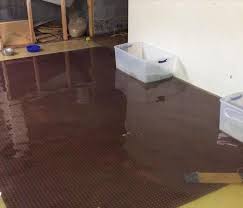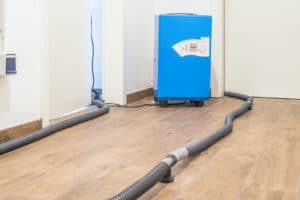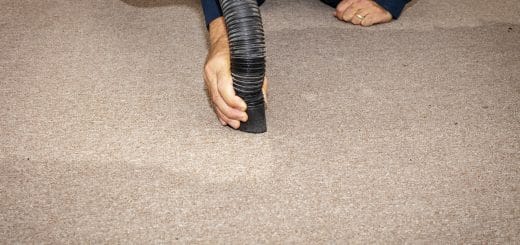5 Steps to Recover from Basement Flooding
Basement floodingFlooding is the overflow or accumulation of water in areas t... More is no stranger to most American homeowners. In fact, statistics from the National Flood Insurance Program reveal that home floodingFlooding is the overflow or accumulation of water in areas t... More is the number one disaster in the country. Insurance companies are swamped with over $3 billion in flood damage claims every single year.
What are common causes of basement flooding?
No basement is safe from floodingFlooding is the overflow or accumulation of water in areas t... More. Being an underground hole, the basement is exposed to the elements for longer durations than any other part of the home. Rainwater that saturates the ground around the foundation is notorious for pooling under ideal—and destructive—conditions.
The perfect environments that leadLead is a heavy metal that can be toxic to humans, especiall... More to pooling water around the perimeter of the home include yards that fail to be effectively graded (or sloped) and a lack of functional gutters. Plus, leaky foundations inevitably contribute to floodingFlooding is the overflow or accumulation of water in areas t... More in the lowest level of homes.
After a heavy rainfall, the moisture in the wet ground seeps through foundation cracks. These minute gaps, when unsealed, are entryways for rainwater and snowmelt. Eventually, the basement transforms into a damp, moisture-filled space. Water damage occurs and moldMold is a type of fungus that grows in damp or humid conditi... More colonies flourish.
Unmaintained gutters also leadLead is a heavy metal that can be toxic to humans, especiall... More to rainwater pooling around the home’s foundation and finding a path into the basement. The natural debris that blocks a gutter causes rainwater to spill over the gutters’ rims and down the home’s siding. The consequence is standing water around the perimeter of the home.
Additionally, a lawn that is improperly sloped leads rainwater toward, instead of away from, the property’s foundation. Naturally, when heavy rains hit the landscape, the water is directed toward the home, leading to pooling water that eventually floods the basement.

Serious basement floodingFlooding is the overflow or accumulation of water in areas t... More requires immediate attention.
Manmade disasters, too, are known to wreak havoc in the basement. Burst plumbing pipes, leaky appliances, like water heaters or water tanks, and loose or broken washing machine water supply hoses are all unanticipated causes of flooding in the basement.
What are the five steps to repair a flooded basement?
Step 1: Proceed with caution
Electricity and water are a lethal mix. When water in the flooded basement reaches the level of the electrical outlets, electrical shock is a possibility for anyone who wades into the water.
To prevent dangerous electrocution or other hazards, cut the power to the home before beginning the recovery process in the basement. If the breaker box door is located in the basement, call the utility company and request that the electricity be shut off.
Flooded gas appliances can be deadly. In homes powered by gas services, it is critical to shut off the gas via the gas main outside the home prior to entering the flooded basement. Experts recommend having utility company professionals turn off the gas, unless the situation is an emergency.
Step 2: Pump out the water
A skillful approach is required when pumping floodwater out of the basement. Removing water too hastily can disrupt the existing pressure between the basement walls and the saturated soil surrounding the foundation, causing the foundation walls to crack or cave inwards.
In instances where the basement floodingFlooding is the overflow or accumulation of water in areas t... More is minimal, the excess water can be suctioned out with a shop vac. If the basement is severely flooded with several feet of water, call a water damage restorationWater damage restoration is the professional process of clea... More company, the fire department or basement waterproofingWaterproofing is the application of materials or coatings de... More company to extract the water.
Step 3: Ventilate and dry the basement
Quickly dryingDrying is the process of removing moisture from materials, s... More the basement, ideally within 48 hours, prevents issues of moldMold is a type of fungus that grows in damp or humid conditi... More growth. Accelerate the dryingDrying is the process of removing moisture from materials, s... More process by opening the basement windows, running a dehumidifierA dehumidifier is a device that removes excess moisture from... More continuously and aerating the space with several powerful fans and air movers (which can be rented from local hardware stores).
Step 4: Salvage or remove affected belongings
Certain flood-affected goods can either be recovered or discarded. The US Environmental Protection Agency warns that any flood-damaged items that are organic or porousPorous describes a material that contains small openings or ... More should be thoroughly dried within 48 hours. If not, moldMold is a type of fungus that grows in damp or humid conditi... More sporesSpores are microscopic reproductive units of fungi or mold t... More will latch on—requiring these goods to be thrown out.
Materials that are susceptible to moldMold is a type of fungus that grows in damp or humid conditi... More infestations include wood, carpeting, fabrics, upholstery and drywall. Once moldMold is a type of fungus that grows in damp or humid conditi... More colonies take hold, usually within 48 hours of coming into contact with floodwaters, safely removing the sporesSpores are microscopic reproductive units of fungi or mold t... More is an impossibility. Consequently, these items should be tossed.
Electrical equipment, like switches, outlets and wiring, that are touched by floodwaters are no longer safe and should be replaced. The portions of drywall that remain above floodwater levels can be salvaged; drywall saturated with floodwater should be immediately replaced.
Step 5: Prevent future basement flooding
The final step in tackling a flooded basement is to prevent a re-occurrence of the catastrophe. Several tacticsTactics are the specific methods or actions used to achieve ... More may be utilized to keep the basement dry. Install a sump pump, a battery-powered backup pump and a generator for maximum basement protection.
Maintain the gutter system, ensuring it is cleaned at least twice annually; downspouts should effectively direct water several feet away from the foundation. Slope the lawn so that it leads water to run down a path away from the foundation. Additionally, seal any and all existing foundation cracks.
When faced with a flooded basement, homeowners should immediately address the problem. A call to a licensed water damage restorationWater damage restoration is the professional process of clea... More company will resolve the issue promptly.
Water Damage RestorationWater damage restoration is the professional process of clea... More
Restoration professionals are experienced in dealing with water damage of all types. Skilled technicians swiftly and accurately assess the water damage, extract the excess water, thoroughly dry the premises, sanitize the affected areas and perform any necessary reconstruction services.
In the hazardous event the sewer backs up, homeowners should find reliable water damage restoration services. Professionals will arrive onsite quickly to apply microbial treatments, clean up and remediate sewageSewage is wastewater containing biological and chemical cont... More, remove stains and fully dry wet structures.












